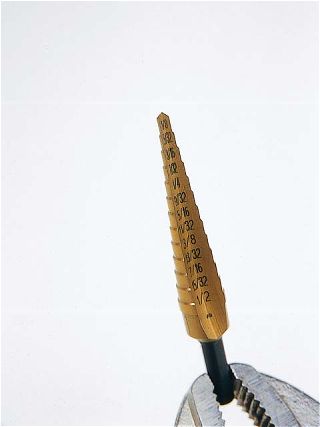 | The Unibit shown here has the titanium nitride coating and goes from 1/8 to 1/2 in. by 1/32-in. steps, though several other configurations are available. At right is a hole made with a conventional #1 size drill bit. Notice the roughness of the bore and the fact that it is shaped more like a Wankel rotor than like a round bolt, as well as the fibers that were torn from a paper towel by the burr on the front side of the hole. At left is a 1/4-in. hole made with the Unibit. It is easy to see that it is round, with a slight deburring/chamfer on the front.
| The Unibit shown here has the titanium nitride coating and goes from 1/8 to 1/2 in. by 1/32-in. steps, though several other configurations are available. At right is a hole made with a conventional #1 size drill bit. Notice the roughness of the bore and the fact that it is shaped more like a Wankel rotor than like a round bolt, as well as the fibers that were torn from a paper towel by the burr on the front side of the hole. At left is a 1/4-in. hole made with the Unibit. It is easy to see that it is round, with a slight deburring/chamfer on the front.
Drilling a hole is probably the most common machining operation performed by an automotive hobbyist, and holes are most often drilled in a thin material such as sheetmetal. Typically, it goes something like this: The bit is working well, making chips, and just as it is about to break through the back, the cutting edges grab the last of the metal and thread the flutes of the bit into the hole. One must pull the bit out and start over, hitting the burrs with some speed to break them off and make a hole that the drill bit can spin smoothly in. The result is a hole that is jagged and frustratingly triangular. A 1/4-in. drill bit never makes a hole in sheetmetal that can pass a 1/4-in. diameter round object, such as a bolt. Doing so requires using a larger bit, resulting in a sloppy, ugly hole.
There is a drill bit that makes nice, clean, perfectly round holes (not cylinder bore round, but good enough for a bolt to pass through), providing mild deburring or a 45-degree chamfer on the front side. The Unibit is a stepped drill bit, made specifically for thin sheet materials. Usually, one-size-fits-all tools are sloppy compromises, but the Unibit's only compromises are the thickness of the material and a limited range of sizes. Each of the several Unibit configurations provides a range of hole diameters, with various minimum, maximum, and increment sizes.
The Unibit has a self-starting tip, or can also be started from a pilot hole made with a conventional drill. One simply works through the steps up to the desired diameter, using the beginning of the next step to deburr the hole on the final size. Because so much of the tool is a solid surface, instead of multiple cutting edges as with a conventional drill, it may tend to make a burr on the back of the hole at each step, which becomes significant as it works through several steps to a larger diameter. This characteristic only becomes troublesome as a Unibit wears and becomes dull. Reducing pressure so the cutting edge does the work helps to alleviate the problem, but, in any case, if the back of the work piece is accessible, it can be deburred with the Unibit simply by entering the hole from the other side. For a few dollars more, Unibits are available with a titanium nitride coating to extend their life. Cutting oil also helps significantly, though some consider it optional in thin sheet material. The mess it leaves could be a problem in many locations, though it does help hold the chips near the hole where they can be easily wiped away. It goes without saying that safety glasses are not optional.
The Unibit became a tool in my box that is used far more than I ever expected. See if it is the same for you.
